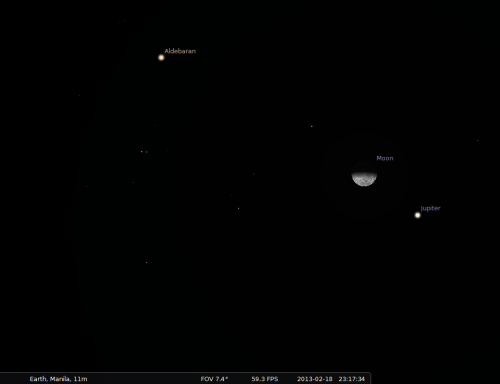Skywatching Highlights: February 2013
Mercury and Mars less than a degree apart after sunset on February 8th
Mercury is well placed in the evening twilight this month, but spotting it won’t be easy. The closest planet to the sun will be low in the west-southwest horizon and will be a bit washed out by twilight’s glow. Binoculars may be needed to find it in the glare of twilight.
On February 8, Mercury will be less than 1 degree from pale orange Mars. The sky won’t be dark enough to see them until they’re just setting, so you’ll need a view to the west that is unobstructed and free from light pollution. They should be visible half an hour after sunset. During the event, Mercury will be about eight times brighter than Mars.
On February 11, a thin crescent moon, one day past new moon will join Mercury and Mars in the twilight sky.
Mercury’s visibility will continue to improve until February 16, when it reaches its greatest eastern elongation from the sun and appears 11 degrees above the west-southwestern horizon. Afterward it will drop back toward the sun, disappearing into bright twilight by the end of the month.
Moon and Jupiter less than 1 degree apart on February 18
Another close conjunction between Jupiter and the Moon, joined by Aldebaran and the Hyades to the left and the Pleiades to the right, will occur on February 18th. At the moment of closest approach, the Moon will be at mag -11.9, and Jupiter at mag -2.4, both in the constellation Taurus.
The pair will be a little too widely separated to fit comfortably within the field of view of a telescope, but will be visible to the naked eye or a through pair of binoculars. To some parts of the world like in the southern Indian Ocean, Southern Australia and Tasmania, this will be viewed as an occultation event where in the Moon will actually pass in front of Jupiter.
Other events this month:
* FEBRUARY 1: Moon ~10 degrees above Spica (in the constellation Virgo)
* FEBRUARY 4: Moon ~7 degrees below Saturn in the eastern sky
* FEBRUARY 5: Moon by “Scorpion’s Crown” before dawn
* FEBRUARY 8: Mercury & Mars in tight conjunction in the western sky shortly after sunset (about 0.4 degrees apart)
* FEBRUARY 9: Moon ~8 degrees above Venus before dawn
* FEBRUARY 11: Thin moon near Mercury & Mars after sunset
* FEBRUARY 16: Mercury in greatest eastern elongation (11 degrees above WSW horizon)
* FEBRUARY 18: Moon and Jupiter less than 1 degree apart
* FEBRUARY 25: Moon and Regulus (in the constellation Leo) ~10 degree apart
# # #
MOON PHASES:
* FEBRUARY 3: Third Quarter Moon at 21:57
* FEBRUARY 10: New Moon at 15:20
* FEBRUARY 18: First Quarter Moon at 04:31
* FEBRUARY 26: Full Moon at 04:26
# # #
Measuring angles in the night sky
The post made reference to angular separations of objects in the night sky, like the moon and planets. If you’re wondering how to measure or approximate these angular distances when you do skygazing, below is a simple guide that will teach you how. The good news is you don’t need any device. You only have to use your own hand. 🙂
Hold your fist at arms length, and:
- Extend your little finger; it’s width is approximately 1 degree.
- Extend your three middle fingers (without the little finger); thats about 5 degrees.
- A clenched fist (thumb to little finger) is about 10 degrees.
- From the tip of the little finger to the tip of the thumb, an extended hand with fingers and thumb splayed subtends about 20 degrees.
Thats it! Those measurements are approximations but are accurate enough to locate the objects in the sky .

























Leave a comment